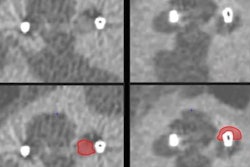
SAN DIEGO - Photon-counting CT scanners might not yet be available for everyday clinical use, but early studies have shown that the technology can offer clear benefits over conventional CT, many of which Cynthia McCollough, PhD, detailed in the opening session of the 2019 International Society for Computed Tomography (ISCT) symposium.
"The technology behind photon-counting detectors is not new, but it is new in the field of CT," she told meeting attendees. McCollough serves as the director of the CT Clinical Innovation Center at the Mayo Clinic in Rochester, MN, and professor of medical physics and biomedical engineering.
Preliminary studies on phantoms and patients have already revealed several obvious advantages of photon-counting CT when used in a clinical research setting -- among them, improved image quality, greater signal-to-noise ratio, and reduced radiation dose.
"Although more manufacturing and clinical work is needed before it can come to market, it has a very bright future," she said.
New CT technology
CT scanners gather information about a patient's internal anatomy by recording the total energy of x-rays passing through the body. These measurements contain a combination of meaningful signals and unwanted electronic noise. Using the conventional scintillating x-ray detectors that are used in all commercial CT scanners, important information that is carried by low-energy photons is more difficult to measure, requiring the use of increasing radiation dose levels.
Conversely, photon-counting CT scanners employ energy-resolving detectors to register the arrival of individual photons, largely eliminating the issue of electronic noise. Recent advancements in detector technology have made it possible to use these types of detectors with the very high rate of detected photons that occur in CT scans.
In 2014, the Mayo Clinic installed the first photon-counting CT scanner capable of imaging humans using standard CT radiation dose and acquired scans of the first human subject in the summer of 2015. Around that time, a second research system was installed at the U.S. National Institutes of Health (NIH) Clinical Center in Bethesda, MD.
Thus far, McCollough and colleagues have scanned more than 300 patients using a photon-counting CT scanner. Assessments of the scans have already demonstrated distinct benefits of the technology over conventional CT scanners.
Photon-counting CT produces particularly striking depictions of the lungs, for example, very clearly displaying airway walls, McCollough noted. In addition, photon-counting CT scans offer a much more detailed view of the inner ear at a considerably lower dose than standard CT.
"We haven't identified a single killer application for photon-counting CT as of yet. Rather, there are multiple compelling arguments for its clinical use," she said.
Potential advantages
During her talk, McCollough highlighted five advantages of photon-counting CT:
- Excluding electronic noise: The inherent ability of photon-counting CT to remove noise allows clinicians to use very low-dose protocols and obtain images showing fewer streaking artifacts and more accurate CT numbers. This is especially important in applications such as CT lung cancer screening, where low dose is a priority, she noted.
- Increasing iodine signal-to-noise ratio: Whereas standard CT relies on increasing radiation dose to better visualize low-contrast, iodinated structures, photon-counting CT has a uniform response to photons of all energies. This ultimately allows photon-counting CT to deliver greater iodine contrast resolution and better dose efficiency. (They estimate radiation dose reductions of roughly 30% to 40%.)
The researchers found that photon-counting CT produced brighter signals of iodinated blood when using tube potential of 140 kV, compared with a conventional CT scanner with a low tube potential setting of 80 kV. The increased iodine signal-to-noise ratio could help in many challenging scenarios, such as imaging metal implants or obese patients, or when the blood iodine concentrations is low, McCollough noted. - Improving spatial resolution: One striking advantage of photon-counting CT is that it can produce images with a spatial resolution of 0.15 mm, comparable to that of existing ultrahigh-resolution CT scanners, without sacrificing dose efficiency. This improved resolution proved its value in delineating submillimeter bony structures in the inner ear, which is critical for installing cochlear implants, as well as depicting airways and fine vasculature.
In a small study, McCollough's team had three neuroradiologists examine CT scans of 10 cadaveric temporal bones using varying slice sizes (0.25 mm and 0.6 mm) that were acquired using a standard CT scanner and a photon-counting CT scanner. They found that the readers consistently preferred the quality of the photon-counting CT scans. - Allowing simultaneous single-kV spectral imaging: Photon-counting CT is able to capture a spectrum of signals (similar to the way dual-energy CT does) but using a single tube voltage. This has allowed the group to achieve much better resolution of stents, eliminate dense calcifications from an image without leaving artificial renderings, and evaluate for gout and bone marrow edema in patients with acute knee injury.
- Distinguishing between multiple K-edge contrast agents: Photon-counting CT could also pave the way for new uses of contrast agents since it is capable of discerning between different contrast agents -- whether it be gadolinium, bismuth, or gold particles -- on the same scan. A radiologist could, for example, use iodine to examine the enhancement of the bowel wall and bismuth to examine the bowel lumen at the same time using a single scan acquisition.
New applications
The clinical potential for photon-counting CT is certainly there as well, McCollough noted. The primary issue is getting the detector manufacturers to deem it valuable enough to warrant widespread commercial production.
"Growing some of the materials required to build photon-counting CT scanners is an art," she told AuntMinnie.com. "The first few years of trying to introduce new detector technology is challenging. ... The detector simply has to yield artifact-free images before it goes to market."
For their part, the researchers are continuing to amass evidence to demonstrate the scanner's value. Most recently, they have discovered a biomarker visible on photon-counting CT scans that can potentially indicate the very early degradation of cartilage in patients suspected of having early osteoarthritis. They have also begun developing algorithms to further reduce image noise and are considering launching a multicenter study with the NIH team using the technology.




















